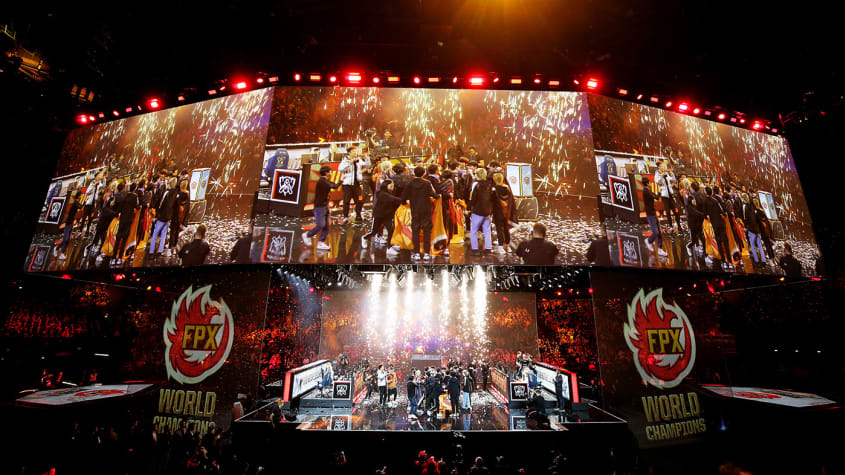“At the start of 2022 a group backed by the Saudi Arabian government bought two of the biggest esports tournament operators in the world, ESL and FaceIt,” he explained. “I think we’ll see more of this happening and it will be a big trend in 2023 and probably beyond.”
But what’s behind the boom in competitive video gaming?

How esports played?
Skilled players take each other on, either individually or in teams, playing popular video games for prize money. The biggest games include Overwatch, “a first-person shooter” game in which futuristic “heroes” fight each other; Defence of the Ancients 2, a multiplayer fantasy “battle arena” game in which teams engage in combat; and complex strategy games such as StarCraft II, in which sci-fi “species” fight for galactic dominance.
The first competitions date back to the 1970s, but they started getting big around 2010, when live streaming on the internet drew in spectators from around the world.
How popular are they?
Very popular. Video gaming is one of the world’s biggest leisure industries. Globally, it generated some $180bn in revenue last year, more than the film and music industries combined. There are an estimated three billion gamers worldwide, more than a third of the world’s population. As a result, vast numbers play esports: one of the most popular games, Rocket League, has more than 80 million players worldwide.
In 2019, Epic Games, publisher of the battle game Fortnite, launched a “World Cup” in which anyone could apply to play. Some 40 million did so: the finals filled 19,000 seats of New York’s Arthur Ashe Stadium, and the winners shared a $30m pot. More than 500 million people watched esports online last year; the biggest events, such as the League of Legends world championship, attracted more than five million viewers.
Are there professional teams?
Many: according to the data company Statista, in 2021 there were 3,600 professional esports players in the US, and about 1,000 each in Russia and China. Their teams, like traditional sports teams, play in tournaments and leagues, and compete for the best players around the world by offering lucrative salaries and rigorous training. These teams attract remarkable levels of devotion from their fans, who follow the ups and downs and scandals – match-fixing, doping – just as football fans do.
There are leagues for all manner of esports.
Last year, Tom Leese, a British professional who plays the football game FIFA, became the first esports player to break the £100,000 transfer fee threshold when he moved from Hashtag United to Excel. Lower-level players may not receive a set wage, instead taking a share of any tournament prize money.
Where does the cash come from?
Today, though, they make money in the way that other professional sports do.
Pro-esports players and teams can also make money from endorsing products – energy drinks, for instance – and branded merchandise: they sell everything from clothing to toys, sculpture and digital game art.
Are esports real sports?
This has long been a controversial question, and different nations have reached different answers. In the UK, esports are classified as games; in Russia, “cybersports” are classified as an official sporting discipline. The International Olympic Committee is currently considering the question, which has a philosophical aspect.
To be a sport, does a game require exertion? Do sports require the manipulation of real-world objects? Is darts a sport? Is snooker? What is clear is that high-level esports require phenomenal reactions and concentration.
But they’re not exactly healthy, are they?
It’s not unheard of for gamers to spend 100 hours a week at their computers. Studies have shown that sitting for six hours a day for two consecutive weeks can increase cholesterol levels, lead to degeneration of muscles, and increase the risk of weight gain and heart disease.
In many respects, this may not be much different from a demanding office job, though studies have also shown that gamers’ heart rates can reach up to 180 beats per minute during matches – almost the stress level of a racing driver.
Will esports overtake sports?
Not any time soon. Established sports have built up dedicated followings over the decades, rooted in particular towns and cities; and they earn a vast amount from TV syndication, which is so far not true of esports.
On the other hand, demography is on esports’ side. The average age of a match-going Premier League fan is over 40, whereas more than 60% of esports fans are under 35. And while participation in traditional sports is falling in much of the world – certainly in the US, though not, for now, in the UK – video games are ubiquitous: according to recent Ofcom figures, 91% of 3- to 15-year-olds in the UK reported playing them.
Life as a pro-gamer
Esports players might not experience the physical demands that traditional athletes do – but the pressures they face are extreme even so, says Julia Llewellyn Smith in The Times. They have intense training schedules, under supervision from an entourage of coaches. There are sports psychologists, nutritionists, scouts and cutting-edge training facilities.
Players for Team Liquid, a major esports team with bases in the Netherlands, Brazil and the US, share flats and complete full 12-hour days in their “office” as they prepare to compete in packed auditoriums in front of thousands or millions of viewers online. Often they then practise more when they get home.
Professional players can start their careers exceptionally young. US-born Victor De Leon III, professionally known as Lil Poison, started playing Halo aged two, and signed his first contract at the age of six. But most also end them pretty early too: players report feeling burnt out by their gruelling schedules, which don’t leave much time for life away from screens; their reflexes also begin to slow. By their late 20s, many professional esports players retire – meaning their career spans can often be far shorter than even those of traditional athletes.
Other Article:
